Page 401 of 497
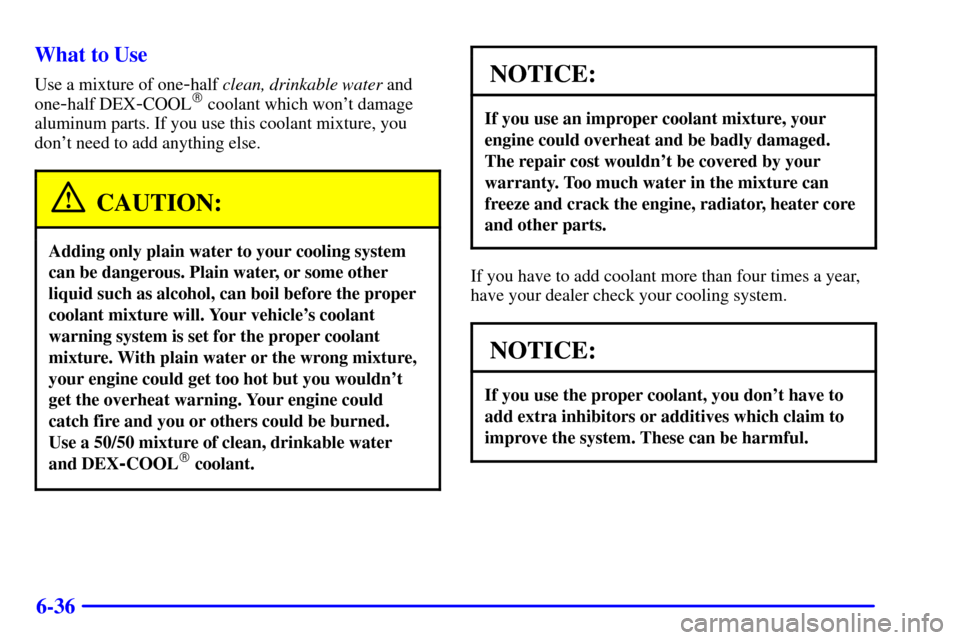
6-36 What to Use
Use a mixture of one-half clean, drinkable water and
one
-half DEX-COOL� coolant which won't damage
aluminum parts. If you use this coolant mixture, you
don't need to add anything else.
CAUTION:
Adding only plain water to your cooling system
can be dangerous. Plain water, or some other
liquid such as alcohol, can boil before the proper
coolant mixture will. Your vehicle's coolant
warning system is set for the proper coolant
mixture. With plain water or the wrong mixture,
your engine could get too hot but you wouldn't
get the overheat warning. Your engine could
catch fire and you or others could be burned.
Use a 50/50 mixture of clean, drinkable water
and DEX
-COOL� coolant.
NOTICE:
If you use an improper coolant mixture, your
engine could overheat and be badly damaged.
The repair cost wouldn't be covered by your
warranty. Too much water in the mixture can
freeze and crack the engine, radiator, heater core
and other parts.
If you have to add coolant more than four times a year,
have your dealer check your cooling system.
NOTICE:
If you use the proper coolant, you don't have to
add extra inhibitors or additives which claim to
improve the system. These can be harmful.
Page 402 of 497
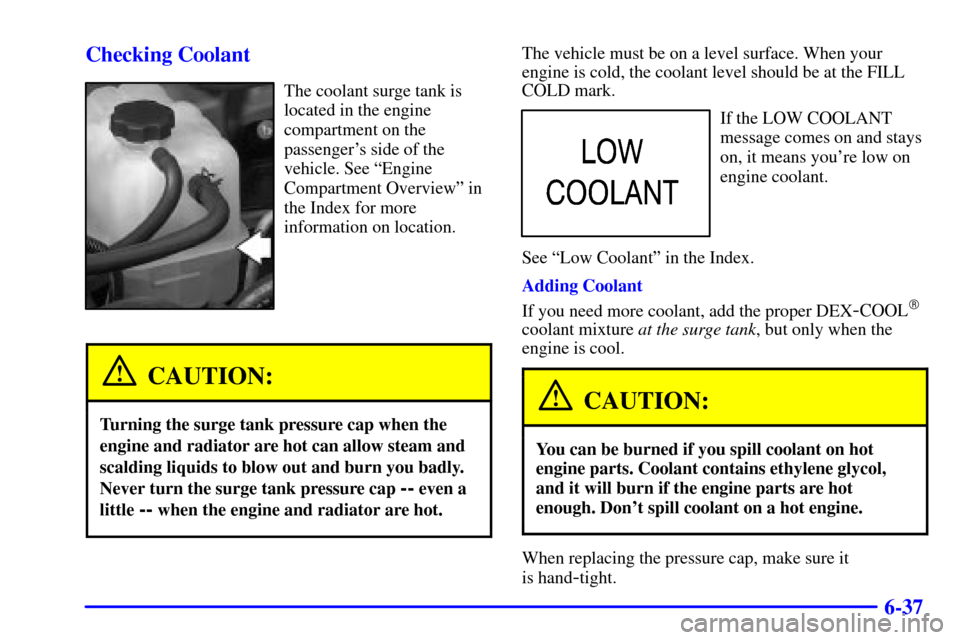
6-37 Checking Coolant
The coolant surge tank is
located in the engine
compartment on the
passenger's side of the
vehicle. See ªEngine
Compartment Overviewº in
the Index for more
information on location.
CAUTION:
Turning the surge tank pressure cap when the
engine and radiator are hot can allow steam and
scalding liquids to blow out and burn you badly.
Never turn the surge tank pressure cap
-- even a
little
-- when the engine and radiator are hot.
The vehicle must be on a level surface. When your
engine is cold, the coolant level should be at the FILL
COLD mark.
If the LOW COOLANT
message comes on and stays
on, it means you're low on
engine coolant.
See ªLow Coolantº in the Index.
Adding Coolant
If you need more coolant, add the proper DEX
-COOL�
coolant mixture at the surge tank, but only when the
engine is cool.
CAUTION:
You can be burned if you spill coolant on hot
engine parts. Coolant contains ethylene glycol,
and it will burn if the engine parts are hot
enough. Don't spill coolant on a hot engine.
When replacing the pressure cap, make sure it
is hand
-tight.
Page 405 of 497
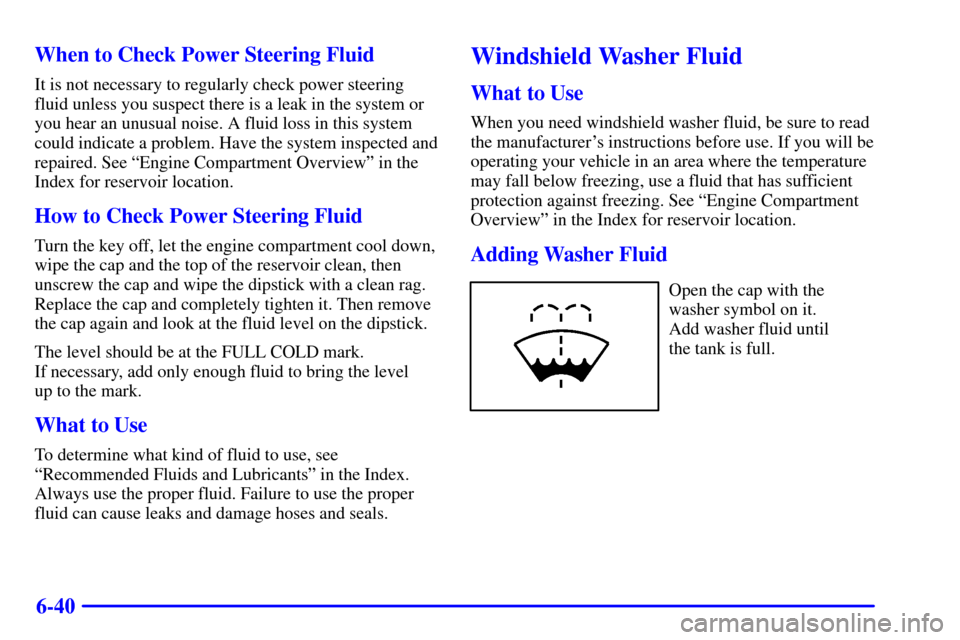
6-40 When to Check Power Steering Fluid
It is not necessary to regularly check power steering
fluid unless you suspect there is a leak in the system or
you hear an unusual noise. A fluid loss in this system
could indicate a problem. Have the system inspected and
repaired. See ªEngine Compartment Overviewº in the
Index for reservoir location.
How to Check Power Steering Fluid
Turn the key off, let the engine compartment cool down,
wipe the cap and the top of the reservoir clean, then
unscrew the cap and wipe the dipstick with a clean rag.
Replace the cap and completely tighten it. Then remove
the cap again and look at the fluid level on the dipstick.
The level should be at the FULL COLD mark.
If necessary, add only enough fluid to bring the level
up to the mark.
What to Use
To determine what kind of fluid to use, see
ªRecommended Fluids and Lubricantsº in the Index.
Always use the proper fluid. Failure to use the proper
fluid can cause leaks and damage hoses and seals.
Windshield Washer Fluid
What to Use
When you need windshield washer fluid, be sure to read
the manufacturer's instructions before use. If you will be
operating your vehicle in an area where the temperature
may fall below freezing, use a fluid that has sufficient
protection against freezing. See ªEngine Compartment
Overviewº in the Index for reservoir location.
Adding Washer Fluid
Open the cap with the
washer symbol on it.
Add washer fluid until
the tank is full.
Page 407 of 497
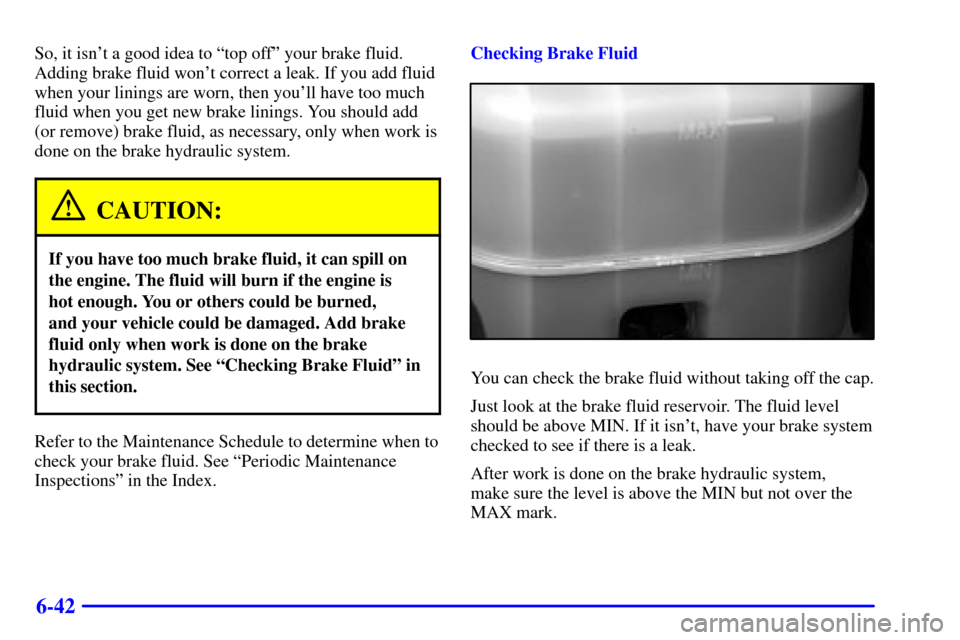
6-42
So, it isn't a good idea to ªtop offº your brake fluid.
Adding brake fluid won't correct a leak. If you add fluid
when your linings are worn, then you'll have too much
fluid when you get new brake linings. You should add
(or remove) brake fluid, as necessary, only when work is
done on the brake hydraulic system.
CAUTION:
If you have too much brake fluid, it can spill on
the engine. The fluid will burn if the engine is
hot enough. You or others could be burned,
and your vehicle could be damaged. Add brake
fluid only when work is done on the brake
hydraulic system. See ªChecking Brake Fluidº in
this section.
Refer to the Maintenance Schedule to determine when to
check your brake fluid. See ªPeriodic Maintenance
Inspectionsº in the Index.Checking Brake Fluid
You can check the brake fluid without taking off the cap.
Just look at the brake fluid reservoir. The fluid level
should be above MIN. If it isn't, have your brake system
checked to see if there is a leak.
After work is done on the brake hydraulic system,
make sure the level is above the MIN but not over the
MAX mark.
Page 452 of 497
6-87 Cooling System Capacity
After refill, the level must be rechecked. See ªCooling Systemº in the Index.
Engine Transmission Quantity
VORTEC 4300 V6 Automatic 12.6 quarts (11.9 L)
VORTEC 4300 V6 Manual 12.9 quarts (12.2 L)
VORTEC 4800 V8 Automatic 13.4 quarts (12.7 L)
VORTEC 4800 V8 Manual 13.7 quarts (13.0 L)
VORTEC 5300 V8 Automatic 13.4 quarts (12.7 L)
VORTEC 5300 V8** Automatic 14.9 quarts (14.1 L)
VORTEC 6000 V8 Automatic 14.8 quarts (14.0 L)
VORTEC 6000 V8* Automatic 14.4 quarts (13.6 L)
VORTEC 6000 V8 Manual 15.2 quarts (14.4 L)
VORTEC 6000 V8* Manual 14.8 quarts (14.0 L)
VORTEC 8100 V8 Manual 21.1 quarts (20.0 L)
VORTEC 8100 V8 Automatic 20.7 quarts (19.6 L)
* Vehicles equipped with the optional engine oil cooler.
** Vehicles equipped with the optional air conditioner.
Page 453 of 497
6-88 Engine Oil with Filter Capacity
After refill, the level must be rechecked. Add enough engine oil so that the fluid is within the proper operating range.
See ªEngine Oilº in the Index.
Engine VIN
Quantity with Filter�
VORTEC 4300 V6 W 4.5 quarts (4.3 L)
VORTEC 4800 V8 V 6.0 quarts (5.7 L)
VORTEC 5300 V8 T 6.0 quarts (5.7 L)
VORTEC 6000 V8 U 6.0 quarts (5.7 L)
VORTEC 8100 V8 G 6.5 quarts (6.1 L)
�Oil filter should be changed at every oil change.
Page 461 of 497
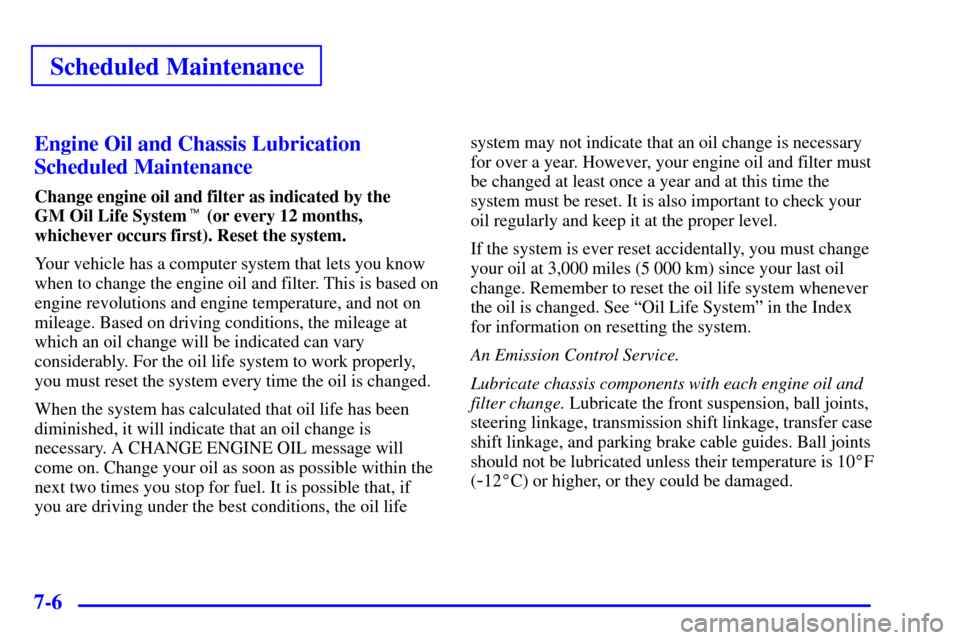
Scheduled Maintenance
7-6Engine Oil and Chassis Lubrication
Scheduled Maintenance
Change engine oil and filter as indicated by the
GM Oil Life System� (or every 12 months,
whichever occurs first). Reset the system.
Your vehicle has a computer system that lets you know
when to change the engine oil and filter. This is based on
engine revolutions and engine temperature, and not on
mileage. Based on driving conditions, the mileage at
which an oil change will be indicated can vary
considerably. For the oil life system to work properly,
you must reset the system every time the oil is changed.
When the system has calculated that oil life has been
diminished, it will indicate that an oil change is
necessary. A CHANGE ENGINE OIL message will
come on. Change your oil as soon as possible within the
next two times you stop for fuel. It is possible that, if
you are driving under the best conditions, the oil lifesystem may not indicate that an oil change is necessary
for over a year. However, your engine oil and filter must
be changed at least once a year and at this time the
system must be reset. It is also important to check your
oil regularly and keep it at the proper level.
If the system is ever reset accidentally, you must change
your oil at 3,000 miles (5 000 km) since your last oil
change. Remember to reset the oil life system whenever
the oil is changed. See ªOil Life Systemº in the Index
for information on resetting the system.
An Emission Control Service.
Lubricate chassis components with each engine oil and
filter change. Lubricate the front suspension, ball joints,
steering linkage, transmission shift linkage, transfer case
shift linkage, and parking brake cable guides. Ball joints
should not be lubricated unless their temperature is 10�F
(
-12�C) or higher, or they could be damaged.
Page 468 of 497
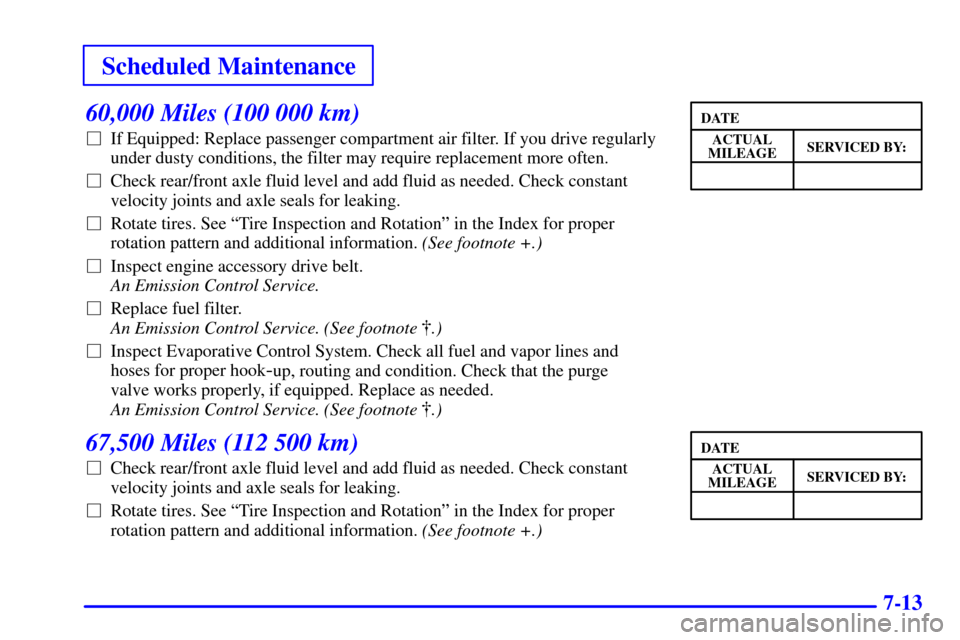
Scheduled Maintenance
7-13
60,000 Miles (100 000 km)
�If Equipped: Replace passenger compartment air filter. If you drive regularly
under dusty conditions, the filter may require replacement more often.
�Check rear/front axle fluid level and add fluid as needed. Check constant
velocity joints and axle seals for leaking.
�Rotate tires. See ªTire Inspection and Rotationº in the Index for proper
rotation pattern and additional information. (See footnote +.)
�Inspect engine accessory drive belt.
An Emission Control Service.
�Replace fuel filter.
An Emission Control Service. (See footnote �.)
�Inspect Evaporative Control System. Check all fuel and vapor lines and
hoses for proper hook
-up, routing and condition. Check that the purge
valve works properly, if equipped. Replace as needed.
An Emission Control Service. (See footnote �.)
67,500 Miles (112 500 km)
�Check rear/front axle fluid level and add fluid as needed. Check constant
velocity joints and axle seals for leaking.
�Rotate tires. See ªTire Inspection and Rotationº in the Index for proper
rotation pattern and additional information. (See footnote +.)
ACTUAL
SERVICED BY:MILEAGE
DATE
ACTUAL
SERVICED BY:MILEAGE
DATE